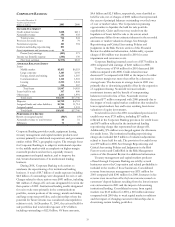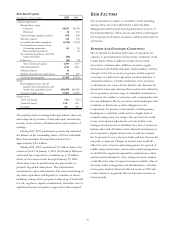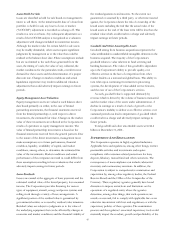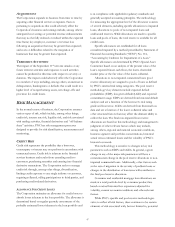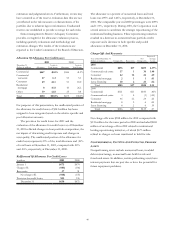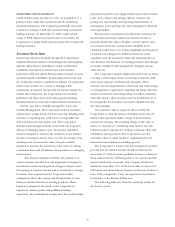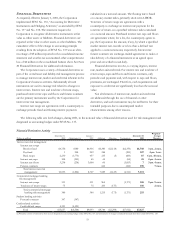PNC Bank 2001 Annual Report Download - page 45
Download and view the complete annual report
Please find page 45 of the 2001 PNC Bank annual report below. You can navigate through the pages in the report by either clicking on the pages listed below, or by using the keyword search tool below to find specific information within the annual report.
43
Risk-Based Capital
December 31 - dollars in millions 2001 2000
Capital components
Shareholders’ equity
Common $5,813 $6,344
Preferred 10 312
Trust preferred capital securities 848 848
Minority interest 134 109
Goodwill and other intangibles (2,174) (2,312)
Net unrealized securities losses
Continuing operations 86 35
Discontinued operations 45
Net unrealized gains on cash flow
hedge derivatives (98)
Other, net (20) (14)
Tier I risk-based capital 4,599 5,367
Subordinated debt 1,616 1,811
Minority interest 36
Eligible allowance for credit losses 707 667
Total risk-based capital $6,958 $7,845
Assets
Risk-weighted assets and off-
balance-sheet instruments, and
market risk equivalent assets $58,958 $62,430
Average tangible assets 67,604 66,809
Capital ratios
Tier I risk-based 7.8% 8.6%
Total risk-based 11.8 12.6
Leverage 6.8 8.0
The capital position is managed through balance sheet size
and composition, issuance of debt and equity instruments,
treasury stock activities, dividend policies and retention of
earnings.
During 2001, PNC purchased a portion and redeemed
the balance of the outstanding shares of Fixed/Adjustable
Rate Noncumulative Preferred Stock Series F for
approximately $301 million.
During 2001, PNC repurchased 9.5 million shares of its
common stock. On January 3, 2002, the Board of Directors
authorized the Corporation to purchase up to 35 million
shares of its common stock through February 29, 2004.
These shares may be purchased in the open market or
privately negotiated transactions. This authorization
terminated any prior authorization. The extent and timing of
any share repurchases will depend on a number of factors
including, among others, progress in disposing of loans held
for sale, regulatory capital considerations, alternative uses of
capital and receipt of regulatory approvals if then required.
RISK FACTORS
The Corporation is subject to a number of risks including,
among others, those described below and in the Risk
Management and Forward-Looking Statements sections of
this Financial Review. These factors and others could impact
the Corporation’s business, financial condition and results of
operations.
BUSINESS AND ECONOMIC CONDITIONS
The Corporation’s business and results of operations are
sensitive to general business and economic conditions in the
United States. These conditions include the level and
movement of interest rates, inflation, monetary supply,
fluctuations in both debt and equity capital markets, and the
strength of the U.S. economy, in general, and the regional
economies in which the Corporation conducts business. A
sustained weakness or further weakening of the economy
could decrease the value of loans held for sale, decrease the
demand for loans and other products and services offered by
the Corporation, increase usage of unfunded commitments
or increase the number of customers and counterparties who
become delinquent, file for protection under bankruptcy laws
or default on their loans or other obligations to the
Corporation. An increase in the number of delinquencies,
bankruptcies or defaults could result in a higher level of
nonperforming assets, net charge-offs, provision for credit
losses, and valuation adjustments on loans held for sale.
Changes in interest rates could affect the value of certain on-
balance-sheet and off-balance-sheet financial instruments of
the Corporation. Higher interest rates would also increase
the Corporation’s cost to borrow funds and may increase the
rate paid on deposits. Changes in interest rates could also
affect the value of assets under management. In a period of
rapidly rising interest rates, certain assets under management
would likely be negatively impacted by reduced asset values
and increased redemptions. Also, changes in equity markets
could affect the value of equity investments and the value of
net assets under management and administration. A decline
in the equity markets adversely affected results in 2001 and
could continue to negatively affect noninterest revenues in
future periods.


